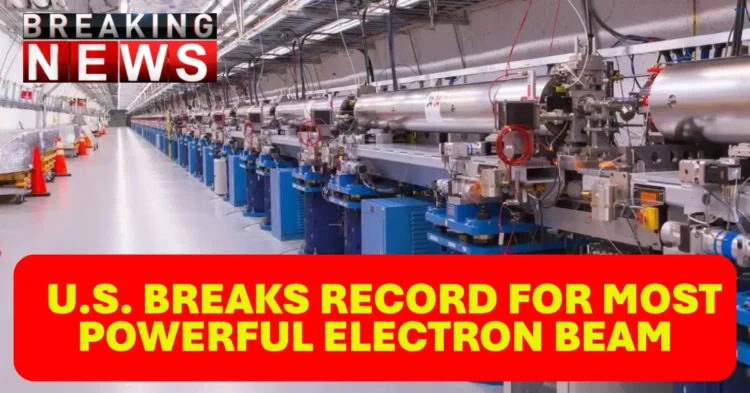The United States has once again asserted its leadership in scientific innovation with a groundbreaking advance at the SLAC National Accelerator Laboratory. Researchers there have developed the most powerful ultrashort electron beam ever created—delivering a peak current five times higher than anything achieved before. This leap forward is not just a triumph in engineering; it marks a pivotal moment for experimental physics, opening new doors across multiple scientific fields.
Table of Contents
What Makes Electron Beams So Special?
Understanding the Difference: Lasers vs. Electron Beams
While laser beams use photons, electron beams are made of actual particles—electrons—accelerated to near light speed and guided by powerful electromagnetic fields. These beams must operate in vacuum conditions and require complex infrastructure to function properly.
Unlike lasers, electron beams interact with matter in fundamentally different ways. This allows scientists to explore a broader range of phenomena, including dense materials, atomic interactions, and plasma behavior under extreme conditions.
SLAC’s FACET-II Now Leads the World in Beam Power
The Facility for Advanced Accelerator Experimental Tests (FACET-II) at SLAC has now overtaken top global research facilities, including Germany’s European XFEL. This comes as countries like China rapidly expand their own scientific infrastructure—especially in fields like nuclear fusion and quantum technology.
SLAC’s success not only affirms America’s edge in foundational physics but also signals its capacity to remain competitive amid rising international efforts.
Overcoming the Beam Power vs. Beam Quality Dilemma
Breaking the Trade-Off Barrier
Historically, increasing an electron beam’s power meant sacrificing quality. As beams were compressed to higher intensities, they would degrade due to radiation and energy loss, limiting their usefulness for precision experiments.
The SLAC team tackled this head-on by integrating techniques from the Linac Coherent Light Source (LCLS), particularly laser-based energy modulation. Rather than relying solely on conventional magnetic fields, they used lasers to manipulate the energy of electrons at microscopic scales.
How It Works
This innovative modulation was applied within the first ten meters of a machine stretching over a kilometer. The real challenge lay in maintaining that energy pattern during transport—something the team achieved after months of rigorous calibration.
According to lead researcher Claudio Emma, “Laser-based modulation offers dramatically improved precision. It lets us control and compress billions of electrons with an accuracy that wasn’t possible before.”
Scientific Possibilities Across the Universe and Beyond
From the Heart of Stars to the Frontiers of Chemistry
The implications are far-reaching. With such an advanced beam, scientists can now replicate plasma filaments observed in stars, test theories about cosmic structures, and study quantum phenomena at scales previously unattainable.
At FACET-II, researchers have already begun advancing plasma wakefield acceleration, a technology that could revolutionize the next generation of particle accelerators. These could one day be smaller, cheaper, and more efficient—bringing high-end research tools to more labs and industries worldwide.
Attosecond Science and Ultrafast Imaging
SLAC’s ultimate goal is to use these beams to produce attosecond-scale light pulses—allowing researchers to capture ultrafast events like electron movement or molecular shifts. Think of it as a camera so fast it can record the tiniest flickers of energy at the atomic level.
The Strategic Importance of American Scientific Infrastructure
This breakthrough arrives as the U.S. continues to lead in space exploration and quantum science. While China makes gains in quantum computing, SLAC’s achievement reinforces America’s strength in core physical sciences.
Claudio Emma invites researchers globally to take part in this progress: “If you need an extreme beam, we have what you need. Let’s work together.”
Beyond Science: Real-World Industrial Impact
Electron beams already have applications in industries ranging from semiconductors and precision manufacturing to medical device sterilization. Enhancing their power and control could revolutionize these sectors, making tools faster, cleaner, and more precise.
Moreover, the expertise developed at SLAC is cultivating a new generation of scientists and engineers—fortifying America’s talent pipeline in high-tech research.
Looking Forward: A New Chapter for U.S. Innovation
From revealing the structure of black holes to probing the mysterious ninth planet of our solar system, American science is pushing limits across every domain. SLAC’s electron beam breakthrough doesn’t just demonstrate technical prowess; it’s a symbol of what’s possible when long-term investment in research and talent pays off.

